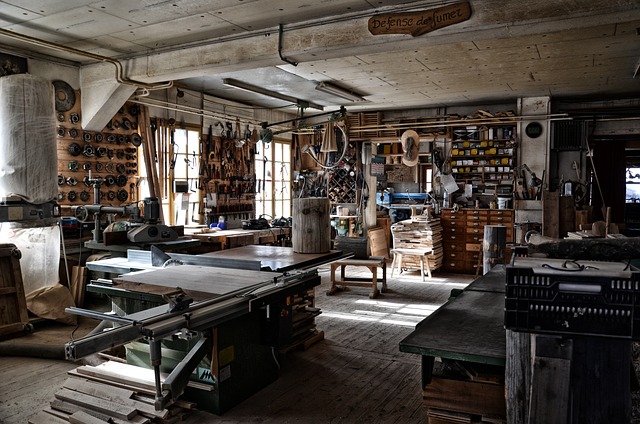Carpenters have various finishing options to enhance and preserve wood, each chosen for its aesthetic appeal and protective qualities. Stains penetrate wood to highlight its natural beauty without overwhelming it, with different formulations like water-based or oil-based stains catering to specific woods and uses. Varnishes and paints coat the surface to shield against environmental factors and come in various sheens for different effects. A clear varnish can bring out wood's natural color and grain, while paint offers a range of colors to transform the piece. The choice between these finishes depends on the wood type, its intended use, and environmental exposure, with exterior woods requiring more resilient finishes. Proper preparation, including inspection, sanding, and cleaning, is crucial for achieving adhesion and a professional-looking finish that protects and maintains the wood's integrity over time. Carpenters carefully select stains, considering factors like color depth, luster, and UV resistance, especially for outdoor use. The right choice not only affects the immediate visual appeal but also ensures the longevity and resilience of the wooden item.
When it comes to preserving and enhancing the natural beauty of wood, the selection of appropriate finishes is paramount. This article delves into the intricacies of finishing wood surfaces with stains, varnishes, or paints, guiding readers through each process from preparation to application. Understanding the different types of wood stains, from penetrating to gel and oil-based options, and selecting the right varnish for various wood types and environmental conditions is essential for achieving a durable and aesthetically pleasing finish. Carpenters play a crucial role in preparing wood for finishing, ensuring the best results. This comprehensive guide covers everything from the art of painting wood to maintaining finishes over time, with a focus on safety precautions and practical tips for working with different woods, including softwoods and hardwoods. By exploring case studies and addressing frequently asked questions, readers will gain insights into successful wood finishing techniques employed by expert carpenters, ensuring their wood projects maintain their charm and integrity for years to come.
- Understanding Wood Surfaces and Their Finishes
- The Role of a Carpenter in Preparing Wood for Finishing
- Types of Wood Stains and Their Applications
Understanding Wood Surfaces and Their Finishes

When it comes to enhancing and preserving wood surfaces, carpenters have a variety of finish options at their disposal, each serving a unique purpose in bringing out the natural beauty of the wood while offering protection against environmental factors. Stains, varnishes, and paints are not mere cosmetic choices but crucial elements that influence both the aesthetic and durability of a wooden piece. A stain, for instance, is a pigmented liquid or gel that soaks into the wood grain, slightly altering its color while allowing the natural texture to remain visible. It’s important to select a stain compatible with the type of wood and the desired outcome, as different woods absorb stains at varying rates.
Varnishes and paints, on the other hand, sit on top of the wood surface, forming a protective barrier against moisture, scratches, and UV rays. Varnishes come in several sheens, from matte to glossy, each highlighting different aspects of the wood’s character. A clear varnish will enhance the natural color and grain patterns, while paint can completely transform the look of a wooden piece with its wide spectrum of colors. The choice between these finishes depends on the intended use of the wood, whether it’s for indoor or outdoor applications, and the level of protection required. For instance, exterior woods require more resilient finishes to withstand harsh weather conditions, while interior surfaces might only need a finish that provides a subtle sheen and easy maintenance. Regardless of the choice, carpenters must apply these finishes with precision and care to ensure a smooth, even surface free from streaks or lap marks. Proper preparation, including sanding and cleaning, is essential before applying any finish to achieve the best results and ensure that the wood’s natural luster shines through.
The Role of a Carpenter in Preparing Wood for Finishing

Carpenters play a pivotal role in preparing wood surfaces for finishing, an intricate process that lays the groundwork for achieving a high-quality, durable, and aesthetically pleasing final product. Prior to applying any stain, varnish, or paint, carpenteters must address several critical steps. These include inspecting the wood for defects such as knots, sap streaks, or cracks that could compromise the finish. They must also smooth rough surfaces with sandpaper, ensuring a uniform texture across the board. This preparation is essential for optimal adhesion and a seamless application of finishing materials, which can significantly affect the longevity and appearance of the wood.
In addition to physical inspections and surface smoothing, carpenters must also select appropriate tools and techniques suited to the type of wood and the desired finish. They may use different grits of sandpaper or finer abrasives like steel wool for more refined surfaces. The choice of wood conditioner or primer may also be dictated by the carpenter based on the absorbency of the wood and the specific demands of the finishing process. This preparation phase is critical as it influences the final outcome, ensuring that when stains, varnishes, or paints are applied, they penetrate evenly, leading to a professional-looking finish that will protect the wood for years to come.
Types of Wood Stains and Their Applications

When it comes to enhancing the natural beauty of wood or preparing a surface for further finishing, carpenters often turn to wood stains as their go-to solution. Wood stains penetrate into the wood grain, allowing the natural patterns and textures to be more pronounced while imparting a consistent color across the surface. There are various types of wood stains, each designed for different species of wood and intended applications. Water-based stains, preferred for their low odor and ease of clean-up, are excellent for interior projects on softwoods like pine or cedar. They offer a wide range of colors and can be used to achieve a semi-transparent or solid stain finish. Oil-based stains, on the other hand, provide a deeper saturation and luster, making them ideal for hardwood floors or furniture where a richer appearance is desired. They are available in gel forms as well, which are perfect for filling in the wood’s natural grooves and creating a more uniform look. Finally, dyes can be used for projects that require a very deep color penetration, suitable for pieces that will see heavy use or exposure to sunlight, ensuring the color remains vibrant over time.
For exterior applications, carpenters must consider UV-resistant stains to protect against the elements and maintain the wood’s appearance. These stains are formulated to withstand the harsh conditions of outdoor environments and are typically oil-based for their durability and protective qualities. They are often used on decks, fences, and garden structures, where they not only enhance the wood’s beauty but also provide essential protection against decay and insects. When selecting a stain, carpenters take into account the type of wood, its intended location, the desired aesthetic outcome, and the level of maintenance the finish will require. The choice between a clear sealant, a semi-transparent option, or a solid stain color is a critical decision that can affect both the functionality and the visual appeal of the wooden piece for years to come.
In conclusion, maintaining and finishing wood surfaces is both an art and a science, one that carpenters expertly navigate. The choice between stains, varnishes, or paints for a wood surface depends on the desired aesthetic, durability requirements, and the nature of the wood itself. Each finish type offers unique benefits and should be applied with care and precision by skilled professionals to ensure the best possible outcome. By understanding the intricacies of wood surfaces and their finishes, homeowners and carpenters alike can achieve long-lasting beauty and protection for their wooden investments. Whether you’re looking to enhance the natural character of the wood or create a protective barrier against the elements, the right finish, skillfully applied, is key to preserving the integrity and appeal of your wood surfaces.
